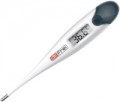Application area
The area of the body for which the thermometer is designed. Note that the normal temperature values for different areas of the body will also be different.
—
Axillary. These devices are meant to be placed under the armpit for temperature measurement. Although the process takes a few minutes as the armpit needs to reach the appropriate temperature, the simplicity of holding the thermometer compensates for this. The slower pace also positively impacts the cost of these thermometers. Widely used in clinical practice, this method is considered the most hygienic among contact temperature measurement techniques. However, its accuracy is slightly lower compared to oral and rectal methods. The normal axillary temperature range is 36.2 – 36.9 °C.
—
Oral. Oral thermometers are used by placing them in the mouth, either under the tongue or behind the cheek (with the former being the preferred method). This technique is generally more accurate and reliable than measuring temperature under the armpit, and it is quicker as the temperature under the tongue remains relatively stable. However, it may not be suitable for young children, those with oral cavity diseases (where local inflammation can result in higher readings), individuals with nasal breathing difficulties (as the mouth must be closed during measurement), and in certain other cases. The normal temperature range under the tongue is 36.6 –
...37.2 °C.
— Forehead. Forehead thermometers measure skin temperature on the forehead, providing a convenient method, especially for children, as the forehead is readily accessible and responsive to body changes. This technique has minimal contraindications. However, it may be less accurate due to environmental influences, detecting elevated temperatures more quickly than specifying exact values. The normal temperature range for the forehead is broad, spanning 35.4 – 37.4 °C. While uncommon in contact models, it is prevalent in infrared ones. Non-contact forehead thermometers can also be used on other surfaces.
— Ear. Thermometers that record the temperature of the eardrum. Such measurements can only be carried out in a non-contact way — otherwise there is a risk of damaging the membrane. Accordingly, ear models are only infrared; their distinctive feature is narrow tips made of soft material that allow you to safely insert the probe into the ear. A similar technique is used mainly to measure body temperature in children; normal readings for the ear range from 36.9 to 37.4 °C.
— Rectal. Rectal thermometers, designed for contact measurement, are considered the most accurate as rectal temperature is largely unaffected by external conditions. However, this method is less convenient, causing discomfort and psychological unease for the patient. It also has specific contraindications, limiting its use to specific cases. Normal temperature range for rectal measurement is 37.3 – 37.7 °C.Measurement duration
The time it takes for a thermometer to provide a temperature reading, from contact or activating the IR sensor to obtaining the result, is crucial for efficiency. Quick measurements save time during temperature checks. However, it's important to mention that for axillary use (see "Application area"), it's advised to keep the thermometer in place for a minimum of 5 minutes, irrespective of the manufacturer's specified measurement time, due to the nature of the procedure.
Measurement range
The range of temperatures that a thermometer can measure.
For measuring body temperature, a range of 35 – 43 °C is considered ample, covering values encountered in individuals with high fever or hypothermia. Although modern medical thermometers may have broader ranges, especially those designed for water and air temperature measurement (e.g., -20 – 100 °C), when used for body temperature, they typically operate within a narrower range. The overall and "solid" measurement ranges are often specified separately in these thermometers.
Reading memory
The number of results the thermometer can store in memory. The ability to
"remember" the results of previous measurements can be very convenient in some cases — in particular, it allows you to accurately track changes in temperature over time. The most advanced models are capable of storing several dozen readings in memory.
Waterproof case
The presence in the design
waterproof case. This feature allows you to thoroughly wash the thermometer; this is especially important for multi-application models (see above) and when using the same device for multiple patients.
Flexible tip
The presence of a
flexible tip in the design. This feature is characteristic only for contact models (see "Type") — it is not required for an IR thermometer. A flexible tip can in some cases simplify the use of the thermometer (particularly for rectal measurements) and also reduce the risk of breakage (for example, a small child trying to break the device will only bend it instead).
Power source
Type of batteries used in thermometers.
— AA. The ubiquitous battery, commonly found everywhere batteries are sold, operates at 1.5 volts, making it widely accessible.
— AAA. The batteries, which are a compact alternative to AA batteries with the same 1.5V voltage, are widely used and suitable for small devices.
— CR2032. One of the most popular types of batteries, with a diameter of 20 mm and a thickness of 3.2 mm. Actual for use in compact devices.

